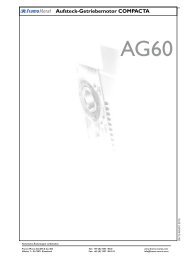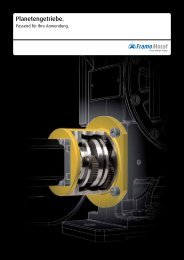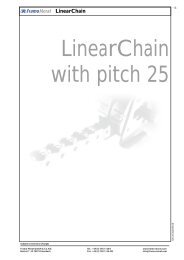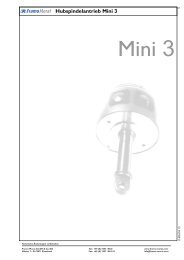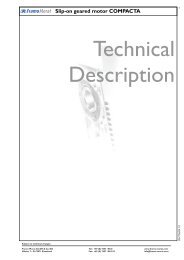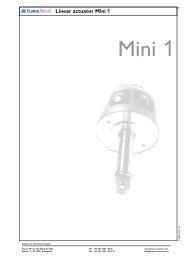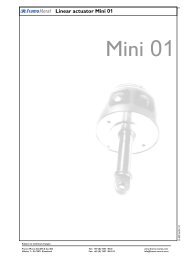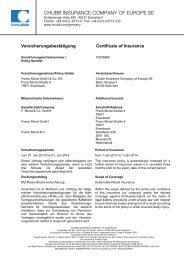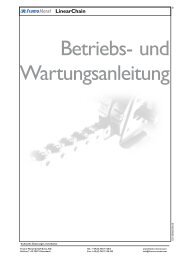Framo - Worm gear sets (Framo-Norm) - Framo Morat
Framo - Worm gear sets (Framo-Norm) - Framo Morat
Framo - Worm gear sets (Framo-Norm) - Framo Morat
Create successful ePaper yourself
Turn your PDF publications into a flip-book with our unique Google optimized e-Paper software.
4<br />
DS-104e1/07.05<br />
Calculation of the torque (T ) with given life time (L )<br />
2 neu hneu<br />
Self locking<br />
Self-locking is affected by lead angle, surface quality, running speed, lubrication and temperature. A distinction<br />
must be made between dynamic (from motion) and static (standstill) self-locking.<br />
Dynamic self locking: lead angle up to 3° with grease lubrication; lead angle up to 2,5° with synthetic oil<br />
lubrication.<br />
Static self locking: lead angle from 3° up to 5° with grease lubrication; lead angle from 2,5° up to 4,5° with<br />
synthetic oil lubrication.<br />
Lead angles above 4,5° or 5° are not self locking.<br />
Shocks or vibrations can neutralize self-locking.<br />
A number of factors associated with lubrication, running speed and loading can favour slip characteristics to<br />
such an extent that self-locking is counteracted.<br />
Therefore it is impossible for us to accept warranty obligations in respect to self-locking.<br />
Mounting of the worm <strong>gear</strong><br />
Reference<br />
surface<br />
T =<br />
2 neu<br />
<strong>Framo</strong> - <strong>Worm</strong> <strong>gear</strong> <strong>sets</strong> (<strong>Framo</strong>-<strong>Norm</strong>)<br />
T x Factor n<br />
2 Nenn. 1<br />
L h neu<br />
L h Nenn<br />
Use the reference surface for latheral adjustment. The latheral tolerance “c” must not<br />
exceed 0,15 mm regardless of the center dictance.<br />
Move <strong>gear</strong> in<br />
direction of arrow<br />
The contact pattern shows installation errors. The contact pattern should tend to the outgoing side. In case of<br />
reversing operation the contact pattern should tend to the center of the worm <strong>gear</strong>.<br />
Efficiency<br />
Generally efficiency depends on the following conditions:<br />
• lead angle of the worm,<br />
• running speed,<br />
• lubrication,<br />
• surface quality,<br />
• mounting conditions.<br />
Correct<br />
contact pattern<br />
Move <strong>gear</strong> in<br />
direction of arrow<br />
The efficiency increases with growing center distance. The use of plain bearings with high coefficients of friction<br />
may affect the overall efficiency. The stated efficiency values apply for optimum mounting conditions.<br />
Starting efficiency<br />
The lubricating film between the flanks is not formed until the <strong>gear</strong> is running. That is the reason for a lower<br />
starting efficiency (approx. 30% below running efficiency).<br />
<strong>Framo</strong> <strong>Morat</strong> GmbH & Co. KG Po-box 10 • D-79869 Eisenbach / Hochschwarzwald Phone +49(0)7657 / 88-0 • Fax +49(0)7657 / 88-444<br />
Höchst 7 • D-79871 Eisenbach / Hochschwarzwald<br />
Homepage: http://www. framo-morat.com E-Mail: info@framo-morat.com



